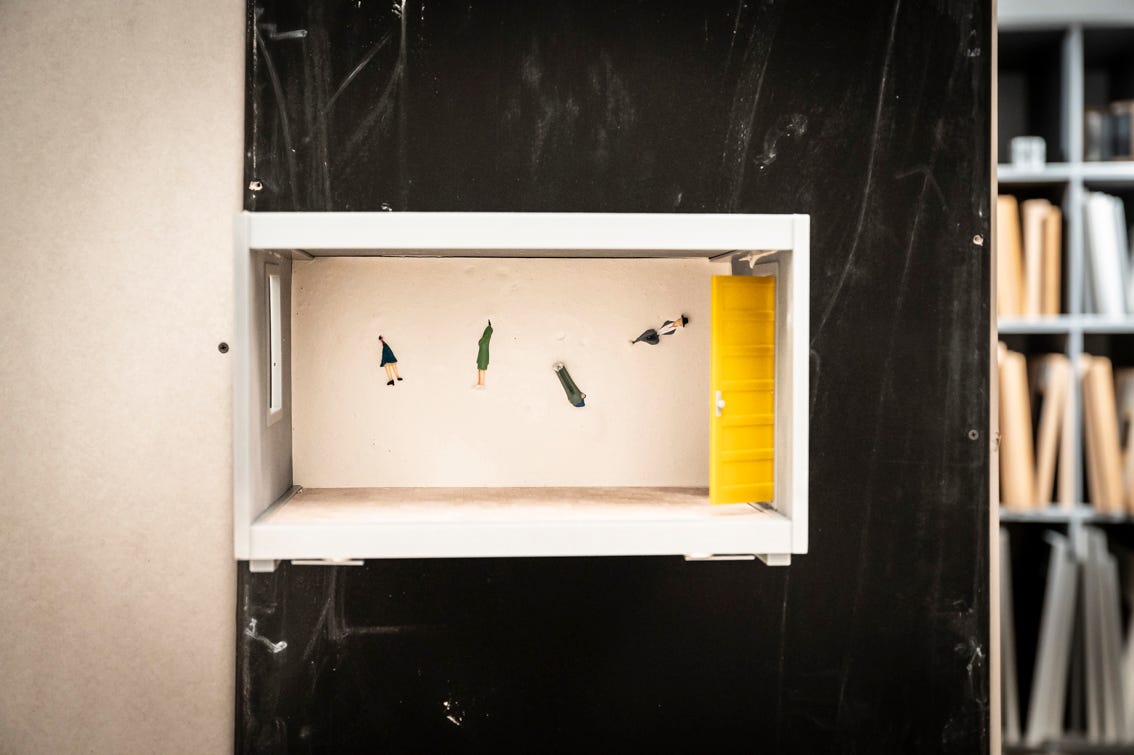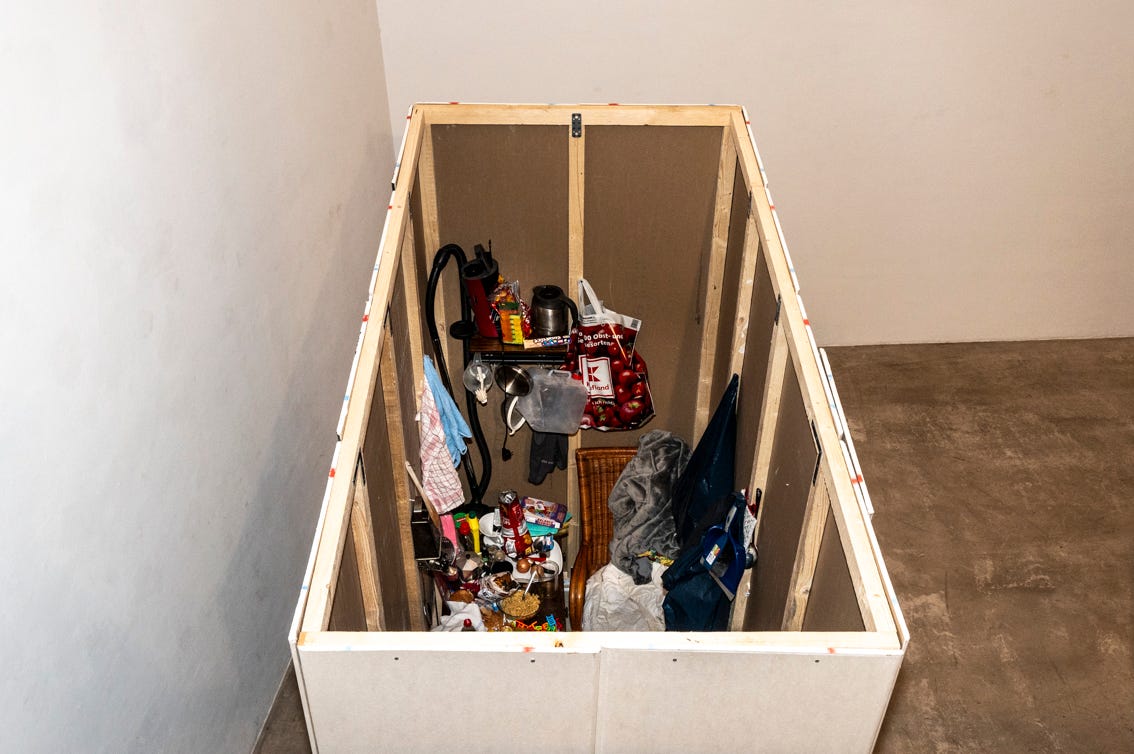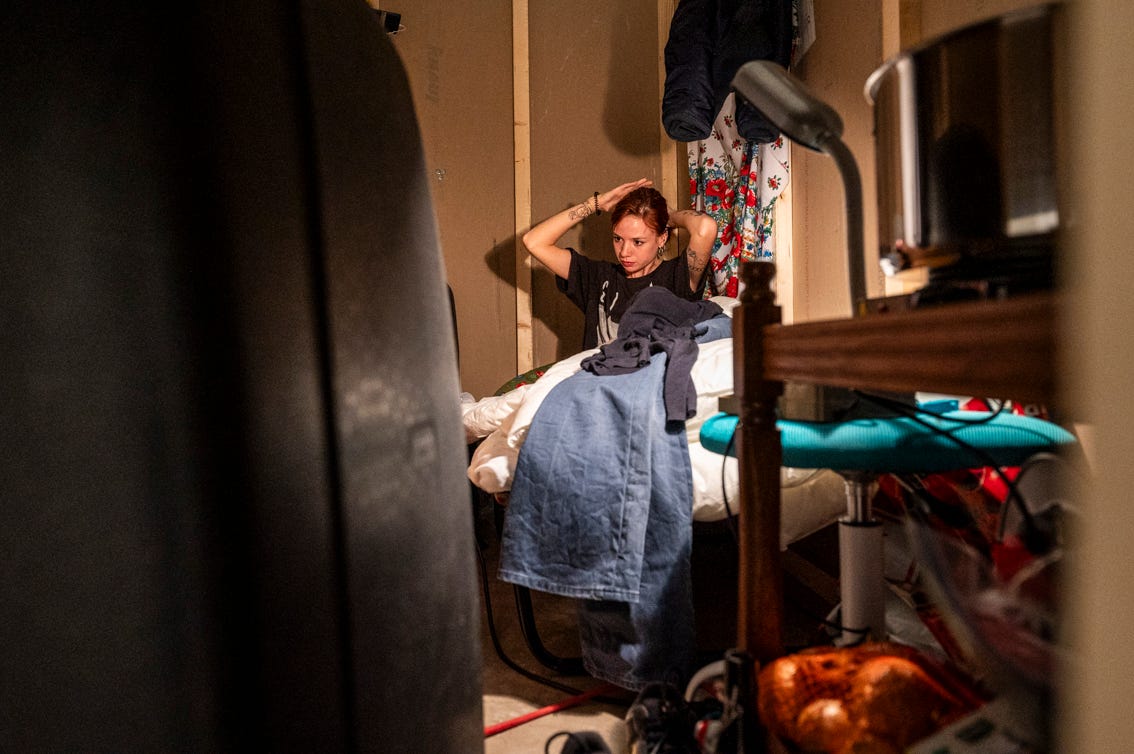Home Improvement: Cristiana Cott Negoescu at artothek Köln
Cristiana's (Millennial, Romanian-German) installation invites to play hide and seek with the work that goes unnoticed.
Let’s Play House!
I enter the exhibition: There’s three tall blocks. They are not really containers; rather, they are like the walls at a construction site that aren’t painted yet. Playhouses are attached to each block, hung at varying heights. If you give me anything remotely in a model house/construction direction, my brain immediately goes to Karla Zipfel (Millennial, German), cause she’s my homegirl.🥁Get it? Anybody laughing behind the screens? At least a giggle, perhaps?
Cristiana’s taking these motives in a different direction than Karla, though. None of the playhouses is furnished. There’s only teeny tiny human figures. Way too small for the houses. The very first playhouse is a proper one: Two stories and several rooms. The other ones are made up of one room only, a door, and not even a window, just an opening in the wall. Just white walls and parkett flooring (with a grey concrete-type exception).

Cristiana didn’t arrange the figures in the houses but smacked them into the plaster walls. The saying “Walls have ears, too” gets a new dimension. They appear very classically gendered with female figurines wearing neat dresses and male ones in suits and hats. Some are bent as if they were supposed to sit. Others stride as if walking somewhere. In one house, one figure is gone and left an imprint in the wall. I look at these sad little humans in their white sterile interiors and immediately hear Adam Driver spit-screaming “EVERYDAY I WAKE UP AND I HOPE YOU’RE DEAD”. I haven’t even seen Marriage Story (2019), I just like quoting stuff.
I just happened to rewatch Gulliver’s Travels (2010) a week or so ago. You know, the Jack Black one. There’s a scene when Gulliver finds himself on the giant’s island and gets kidnapped by the giant girl who forces him to play a doll in her playhouse. There’s something haunting about playhouses: This idea that you can force an imitation of a human into perfect roles to live out your blissful domestic fantasies. Speaking of, Crisitana serves us another type of giant playhouse fantasy here, hang on!
The (Dis)Play of Work
I notice a tiny opening in the lower part of one walled structure. Just wide enough for an adult to crawl through. I bend down to have a better look: I see some trash. Is it trash? Well, that depends if you’re still gonna use the stuff in question or not. Did somebody forget their stuff while installing the show? I wouldn’t trust an art handler who drinks at work, some liquor shots were lying around. I was unsure if I was even meant to see this inner part, it looked so unintentional. As I walk around, I realize that all three blocks have an opening. I look inside each. There’s a whole ass studio inside! There’s discounter bags, food cans, baskets, empty plastic water bottles, dish soap, cooking tools, a bed, and oh! A suitcase! Are these those stylish tiny houses all the Millennials used to drool over on Instagram back in 2018? Doesn’t look as romantic as online…

It gets even more interesting once upstairs: I see a time clock (such a stupid term, like what else if not time is a clock indicating anyway? I digress…), a bracket for stamped time cards (very old-school), some folders, a work desk, and a TV with a keyboard. There’s also a framed artwork hanging on the wall. It’s a picture of what looks like microscopic cells or liquids. You know, one of those wobbly pictures where the images switch depending on your perspective. I didn’t get how it ties into the vibe of the exhibition, so let’s just skip that.
The screen plays a video on repeat from the opening performance. The camera films mostly from the second floor down into the houses. I can really see everything from up here. Feels like I’m doing surveillance. NO, EVIL VOICES, GO AWAY, I WILL NOT QUOTE MICHEL FOUCAULT (1926-84, French) WITH THE PANOPTICON EFFECT OF CONSTANT SURVEILLANCE, LEAVE ME ALONE! Three performers go about their business inside: They cook, eat, write, lie in bed, chill, they pack suitcases. I felt my body jolt when one of them yeeted a suitcase onto the bed: WITH THE WHEELS ON THE BEDSHEETS! Jail, right away. They then crawl out with their suitcases, exchange them, and at one point each performer goes upstairs to stamp their timecard.

But that’s all in the video. I didn’t get to see the performance live. What are they doing? A performance, obviously, no shit, but what exactly are they doing? Them stamping timecards should mean that they do some form of labour that is tracked. What is that labor?
The Art of Maintenance
I also just happened to learn about Maintenance Art recently. It was a session in that economies of the arts course I told you about in my Frenzy Höhne (Millennial, German) review. In that course, we looked at Mierle Laderman Ukeles (Silent Generation, US-American) work: She’d expose the work that usually goes unseen, work like cleaning, repair, and maintenance that is done best when you don’t see traces. I remember the Spanish Pavilion at the Biennale last year worked on the logistics and infrastructures of food. They also presented work about cooking, a form of work that is often done in a separate room, hidden away.

Work that goes into maintenance and care, the structures we need to go on with our personal lives is most of the times kept away from sight. Even though she primarily talks about domestic work and not work outside of the personal home as in the case of Cristiana’s exhibition, I highly recommend having a look at Alice Capelle’s (Millennial, French) video essay “we must pay the tradwives (?)” on this topic.
But as I think about it: Does Cristiana shed light on work specifically outside of the home? Domestic and contractual work blend into one another as the performers seemingly inhabit the exhibition. Where do you draw the line between the work they are hired for and the work they need to do to sustain themselves (like cooking) in order to be able to fulfill their contractual obligations? Not to mention the precarious circumstances: Confinement in boxes, crawling through slits proportionally the size of a dog door which one could interpret as a humiliation ritual in a way, and all of that under the constant observation of visitors. Sure, this is only a performance. It’s not the same as when people work for pennies day by day without any outlook on improvement. Just know that behind the walls, there’s always people keeping it going.
Cristiana Cott Negoescu: Verborgenes Segment, until December 21, 2024 at artothek Köln
artothek Köln
Am Hof 50
50667 Cologne
Website
Instagram: @artothekkoeln @cristiana_cott
Performers: @rabea_chatha @markushenschler @elmarrueger
You know the drill: Like, comment, share. I appreciate it a lot. Thank you so much for being here!
See you soon!!!
Jennifer
The Gen Z Art Critic



